| |
- January 1939,
- Hitler predicts in a speech to the "Reichstag" that a war in Europe would lead to "the annihilation of the Jewish race in Europe":"The destruction of the Jews", "Auswanderung oder Evakuierung".
- February 1939,
- Japanese troops occupy Hainan Island.
- 15 March 1939,
- Germany troops move to occupy Czechoslovakia. The German Protectorate of Bohemia and Moravia are claimed.

The Sdkfz-231 was the most advanced cross- country wheeled vehicle in the world. Their primary role was to provide infantry support and they well served up till 1942. This armored car carried a 20mm cannon and could defeat light tanks. - 18 March 1939,
- Stalin ask for coalition against Hitler, Chamberlain refused, maybe Neville was right?
- 22 March 1939,
- "Das Mermelgebiet" annexed by the German Reich.
- 28 March 1939,
- The Spanish Civil War ended, Madrid surrenders; General Franco in Madrid.
- April 1939,
- Great Britain and France guarantee the armed help to Greece and Romania, should they be attacked by Germany or Italy. Formal Anglo-French guarantees are presented to Poland.
- 7 April 1939,
- Italian troops invade Albania,
The policies and financial dealings of the Albanian King force Italy to occupy Albania, in which it has long standing political and financial interests.
Germany abrogates the 1934 Nonaggression Pact and the 1935 Anglo-German Naval Agreement. - 14 April 1939,
- Roosevelt ask Hitler and Mussolini to stop the violence and make a proposal to hold a conference.
- May 1939,
- From May to September 1939 Japan and the Soviet Union fought a fierce, large-scale undeclared war on the Mongolian plains that ended with a decisive Soviet victory with two important results: Japan reoriented its strategic emphasis toward the south, leading to war with the United States, Britain, and the Netherlands; and Russia freed itself from the fear of fighting on two fronts, thus vitally affecting the course of the war with Germany.
The second stage of China's War of Resistance Against Japan stretched from the Suizao Campaign of May 1939 to the Changde Campaign of March 1944. In this stage, everyone was in the war together. From the cities to the villages, the whole of society was mobilized. - 22 May 1939,
- Germany and Italy sign "The Pact of Steel," a formal alliance.
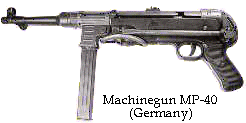
MP-40 (Germany) Caliber: 9x19mm Luger/Para
Weight: 4,7 kg loaded, 4,03 kg empty
Lenght (stock closed/open): 630/833 mm
Barrel lenght: mm
Rate of fire: 500 rounds per minute
Magazine capacity: 32 rounds
Effective range: ca. 100 metersThe MP-38 and MP-40, often incorrectly referred as "Schmeissers", were developed by german engineer Follmer at the Erma company and adopted by Wehrmacht (German Army) in 1938 and 1940, respectively. The MP-40 is a further modification of the MP-38. Total of some 1.2 millions of MP-38/40 were manufactured prior and during WW2. Initially, MP-38 was intended for use by paratroopers and vehicle crews, but later was widely used by german infantry. Both MP-38 and MP-40 were blowback operated, full auto only submachine guns. MP-38 featured steel machined receiver, while MP-40 featured stamped receiver and stamped magazine veil to make the gun cheaper. The charging handle (located at the left side of the receiver) was used as a safety, locking the bolt in forward or rearward position when placed in cut slots in the receiver. Both MP-38 and MP-40 fired from the open bolt. Both featured special rate of fire reducer, that resulted in very controllable rate of fire of some 400-500 rounds per minute. Both guns featured special detail below the barrel to use the guns from armoured wehicles. Both guns featured underfolding steel buttstock. Both MP-38 and MP-40 featured fixed and hooded front sight and flippable rear sight with settings for 100 and 200 meters. The main drawbacks of the MP 38/40 were the lack of the front handguards that often resulted burned hands during the sustained fire, and the lack of the effective range, when compared to its soviet counterparts (PPSch-41, PPS-43), chambered for more powerful 7.62mm TT round. - August 1939,
- Battle of Khalkin Gol. The Battle of Khalkin Gol was a major Russian victory over the Japanese Kwangtung Army in August 1939 on the border of Manchuria and outer Mongolia. It was the most disastrous defeat ever suffered by the Japanese Army.
- 15 August 1939,
- Indian troops arrive in Egypt to reinforce British forces around the Suez Canal.
- 19 August 1939,
- Fourteen German U-boats are sent to patrol the North Atlantic Ocean.
- Sharkhunters
- The U-boat bases, by Matthieu Serra
Relative Strength at Sea before WW II Germany Great-Britain France Aircraft carriers - 7 1 Carriers - 2 1 Battle-ships 2 15 7 Armoured ships 3 - 7 Coasters - 3 - Heavy cruisers 2 15 7 Light cruisers 6 49 11 Torpedo-boats/destroyers 38 230 81 Minelayers/cruisers - 7 4 Mine sweepers 72 46 16 Escort vessels 10 55 8 Torpedo motor-boats 25 44 50 Submarine/U-boats 57 62 79 - 23 August 1939,
- Germany and the Soviet Union signed a non-aggression pact in Moscow, a secret protocol dividing eastern Europe into spheres of influence.
- 26 August 1939,
- Hitler's garantees the neutrality of Belgium, Netherlands, Luxembourg, Denmark and Swiss.
- 31 August 1939,
- German SS troops put on a false attack on a German radio station at Gliewitz.Dressed in Polish uniforms to convince the world that Poland is the aggressor nation and to justify their comming invasion of Poland.
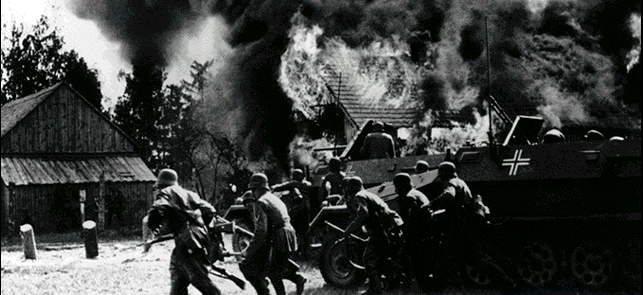
- 1 September 1939,
- (till 28 September). The German naval training ship 'Schleswig Holstein' fires opening shots of World War II and shells the Polish naval base at Westerplatte.
The navy intended to use the World War I battleship Schleswig-Holstein, 3 cruisers, and two flotillas of destroyers to bombard shore installations at Gdynia and the garrison at Hel (north of Danzig).
"Operation Weiss": German troops invade Poland. German tanks thundered across the Polish border at precisely 0445 hours, supported by Junkers Ju87 ("Stuka" named Sturzkampfflugzeug) dive-bombers.
Adolf Hitler was working on the new kind of warfare "Blitzkrieg", Lightning War that involved massive use of tanks, motorized infantry and airforce. Tactics of Blitzkrieg designed new role for tanks, spearheads for quick penetration of enemy territory.
At 9.00 am England and France issue an ultimatum to Germany.Relative strenght at the German invasion of Poland Germany Poland Inf. div. 46 38 Motor. div. 4¾ 11 Cavalry-Brigades Light div. 4 2 Motorized Brigades Tank div. 7 45 Battalions frontier quard Tanks 3200 600 ca. Bombers 1176 146 Fighters 771 315 50% old models Scouting planes 356 325 50% old models Other planes 981 56 Battle-ships 2 -- Cruisers -- -- Destroyers -- 4 Submarine 7 5 Little vessels -- 8 Torpedo-boats -- 2 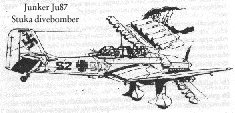
- Feldgrau, the German armed forces 1918-1945
- Achtung Panzer!, by George Parada.
- Panzer battles!
- Tanks!, by the Technical Tyrannosaur.
- 2. Panzer Division
- Panzers Of The Reich
- 2 September 1939,
- Italy declares neutrality in the German/Poland conflict.
The ocean liner S.S. Athenia is torpedoed by the German U-boat U30. Over 112 civilians died at sea, 69 women, 16 children and 28 men. America and Canada were popular destinations, trying to escape from War. - 3 September 1939,
- Begin of World War II. Irak and Saudia-Arabia break diplomatic relations, Great Britain and France, follow by India, Australia, South Africa and New Zealand, declare war on Germany and begin the phoney war ("drole de guerre") in the west.
Winston Churchill becomes Naval Minister and is First Lord of the Admirality in the Britisch Cabinet.Germany invaded Poland on 1 September 1939. As German armoured columns drove deep into Poland, the Luftwaffe had control of the air. The speed of the invasion gave it the name Blitzkrieg, or lightning war. Between the wars Danzig had been a free city which Hitler was eager to have as part of Germany. The Polish armies were soon encircled or forced to retreat. Although Britain and France declared war on 3 September, they were unable to intervene effectively on Poland's behalf. Germany's Blitzkrieg overran Poland from the west and on 17 September it was invaded by the Soviet Union from the east. On 27 September 1939 Warsaw surrendered and, two days later, Germany and the Soviet Union signed a treaty of friendship which partitioned Poland between them.
Britain declares war:
- Biography of Heinz Guderian, Guderian commanded XIX Panzer Corps in the Polish Campaign, by Jan Willem Westra.
- 4 September 1939,
- Where Polish defensive lines are formed they are no match for the rampaging German ground forces. The Polish air force is short of ammunition and many aircraft are destroyed on the ground. No general mobilisation of the German forces at home has yet been ordered; no shots have yet been fired on the Western Front. The British announce successful raids on the German naval bases at Wilhelmshaven and Brunsbuttel despite inclement weather and vigorous anti-aircraft fire. The report is countered by the Germans who claim no bomb damage and five of the twelve aircraft shot down. The Germans announce that they are mining the western Baltic. In London, press agency reports confirm the torpedoing of the British liner SS Athenia with 1.400 passengers on board. The attack was mounted by U30 whose captain took the blacked-out ship for an armed merchant cruiser. Embarrassed by the bad press the sinking brings, the Germans first blame the attack on the British themselves, and subsequently ensure that the relevant entry is deleted from the U-boat's log.
British air force bombs German warships at Kiel. - 5 September 1939,
- A Anson reconnaissance aircraft of the RAF attacks two British submarines by mistake. Its depth-charges score a direct hit on the HMS Snapper. The first British freighter is sunk, a small steamer Bosnia, which is lost to Leutnant-zur-See Prien's U47. Later in the day U48 sinks the armed merchantman Royal Sceptre.
Neutrality statement of the United States. The new Prime Minister, Nobuyuki Abe, from Japan promises to keep out of the war in Europe.Population and industrial capacity Population in 1939 Steel output in tons UK 47.961.000 13.192.000 France 41.600.000 6.221.000 USSR 190.000.000 18.800.000 USA 132.122.000 51.380.000 Germany (including Austria) 76.008.000 23.329.000 Italy 44.223.000 2.323.000 Japan 71.400.000 5.811.000 In population and in industrial capacity , the allies, even after losing France, were stronger than the axis powers. Population and industrial capacity by the British Empire Forces Population in 1939 Steel production in tons (1939) Canada 11.682.000 1.407.000 South Africa (white) 2.161.000 250.000 Australia 6.807.000 1.189.000 New Zealand 1.585.000 -- India 374.200.000 1.035.000 The British Commonwealth and Empire possessed further resources for war. Canada and Australia had significant industries, and their populations, like those of New Zealand and white South Africa, were well-educated and physically and mentally capable of providing high-quality recruits. These 4 self-governing 'dominions' followed the British lead and declared war 1939. - 7 September 1939,
- France troops cross the German border at the "Saar-front".
- 8 September 1939,
- After days of naval bombardment and the landing of assault troops, the Westplatte garrison surrenders.
- 16 September 1939,
- Britain starts convoy service for merchant shipping.
The British Carrier "Courageous", 22.500 tons, sunk by the U-29, German Kriegsmarine.
The Home Front during the Phoney War,
The first months of the war were an anti-climax for the majority of the British people. In anticipation of devastating air raids, children were hastily evacuated from expected target areas, a strict blackout was imposed and nearly all forms of popular entertainment were abruptly halted. When no great onslaught from the air occurred, relief led to a slackening of precautions. These quiet months from September 1939 until May 1940 were known as 'the phoney war.
About one and half million people, mostly children, were evacuated from the towns and cities to the countryside to avoid the expected air raids in the autumn of 1939. Many city children from poor parents found themselves in strange surroundings and their hosts were sometimes startled by the gulf between them. For instance, many children were unaccustomed to a proper bathroom in the house. The quiet of the early months of war meant that many mothers took their children home again. However, as the threatened air raids began later in 1940, a second wave of evacuees went to the country. Some parents, usually the more affluent, sent their children to friends and relatives overseas for the duration of the war. Canada and America were popular destinations. - 17 September 1939,
- Russian troops invade eastern Poland.
- Map of Poland, blitz during the first 15 days.
- 19 September 1939,
- Soviet and Germany meet at Brest-Litovsk.
- 24 September 1939,
- Began of the bombing of Warsaw with 1150 bombers. Warsaw is blitzed from the air as the German ground forces prepare for an assault on the capital.
- 25 September 1939,
- Warsaw again bombed by 400 German aircraft dropping incendiary, highexplosive bombs. The water pipes ruptured and its fire-fighters evacuated, the fires cannot be quenched.
Germans numerical strength modern warplanes 1938 Bombers 1466 Fighters 920 1939 Bombers 1553 Fighters 1090 1940 Bombers 1558 Fighters 1290 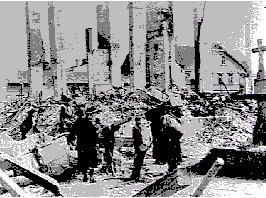
The ruins of Warsaw - 27 September 1939,
- Warschau (Poland) surrenders to Nazi Germany.
- 29 September 1939,
- Form of German-Russia treaty of frontier- and friendship at Moskou, providing for division of Poland. Esthonia signs mutual assistance pact with Sovjet Union.
- 2 October 1939,
- The Pan-American Conference sets up the 300 mile security and neutrality zone around the American coast agreed on 23 September. Within this zone all hostile actions by the belligerent powers is forbidden.
- 6 October 1939,
- The last Polish ground troops surrender. Polish national losses: 700.000 men captured by the Germans, 200.000 men by the Russians and great loss of life; more than 120.000 troops could escape. Thereby German lost 10.000 men and Russia several hundred.
- 13 October 1939,
- Admiral Donitz attempts his first 'wolf pack' deployment of U-boats tactics, in which groups of submarines were assembled to engage in sustained attacks on a convoy, but without success.
- 14 October 1939,
- The British Royal Navy battleship HMS Royal Oak sunk by the German U-boat U47 (Leutnant Prien), which has penetrated the hiding place of the English fleet in the bay of Scapa Flow (Scotland) at 1.23u, with 833 men on board.
- 4 November 1939,
- Neutrality Act of 1939 becomes law. USA neutrality law amended, modifying embargo on arms sales to belligerents ("cash and carry").
- 8 November 1939,
- The first murder attempt on Adolf Hitler is made in a Bürgerbräukeller (a Munich beer hall) in Munchen by carpenter George Elser.

The wreckage caused by the bomb explosion in the Munich beer-hall. Hitler left the hall 27 minutes before the explosion took place. Then the ceiling collapsed and the platform from which Hitler had been speaking was buried 10ft under debris. - 15 November 1939,
- "Völkische Ausrottungsznahmen" in Poland, the leader Frank and Seys-Inquart order Jews to wear a white bracelet with a "Star of David".
- 30 November 1939,
- The Russian-Finnish Winterwar: Russian troops invade Finland, in winter, and reach the Mannerheim Line, Finland's main defensive position reaches five days later, with few access roads, very low temperature (-46º) and in the North constantly darkness.
Russia attacks Finland, but the invasion only penetrates border areas and is carried out so inefficiently that Germany (and the world) thinks the Russian army is of poor quality. But Russia had purged its officer corps in the three years before and not yet completed the training of enough officers. There is no formal declaration of war. The Finns have a minuscule army of about 30.000 men, a few old tanks and aircraft and little ammunition; they will capture more matérial in their few victories than by new manufacture. Finland is attacked on all fronts and Helsinki is bombed from the air. Hopelessly outnumbered and under-equipped, and without supportive allies, the Finns have only the climate and terrain on their side. In many instances the invaders encounter no opposition for days at a time. The Sovjet Baltic Fleet joins the operation with the aim of controlling the Gulf of Finland. This stimulates Great Britain to move against the port of Narvik, to free it for Allied use in supplying Finland.
Denmark, Sweden and Norway declare their strict neutrality in the Russo-Finnish war.Relative Strength at the begin of Russian-Finnish Winterwar, at full length along Fins-Russian border. Sowjet- Unie Finland ca. 500.000 men ca. 14.000 men ca. 30 divisions 10 divisions 800 planes 7 brigades -- 150 planes - The Battles of the Winter War
- C.G.E Mannerheim in the history of Finland
- Summary of Finland in WW II
- Address by [Finnish] Prime Minister A.K. Cajander of 23 November 1939, by Pauli Kruhse
- Håkans Aviation page - Biplane fighter aces from the Second World War
- Russian military power of 30-40th
- December 1939,
- The Finnish Government ask the League of Nations for intervention, but it will be some time before the League convenes its meeting.
Finnish 9th Division defeated Russian 163th Division near Suomussalmi. Russian offensive no success. - 13 December 1939,
- Battle of the River Plate. The Admiral Graf Spee had been operating very successfully aginst merchant shipping in the South Atlantic when she was caught off the River Plate by the British cruisers Achilles, Ajax, and Exeter, still with only superficial damage.
- 17 December 1939,
- The German battleship Graf Spee is scuttled off the coast of Montevideo, Uraguary. Few days later Captain Langsdorf of the Graf Spee shoot himself through the head.
The Battle of the River Plate
The German fleet included several fast ships known as 'pocket battleships' intended for commerce raiding. One of the earliest naval encounters of the war was the Battle of the River Plate off Montevideo between a German pocket battleship, Admiral Graf Spee, and British ships. The Admiral Graf Spee had been operating very successfully against merchant shipping in the South Atlantic when she was caught off the River Plate on 13 December 1939 by the British cruisers, Achilles, Ajax and Exeter. After fierce fighting in the open sea, she was driven to scuttle herself.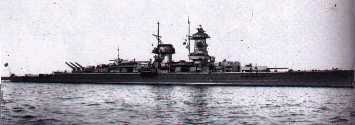
The German battleship Graf Spee